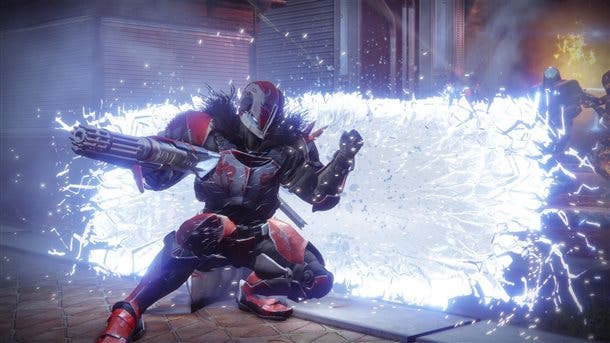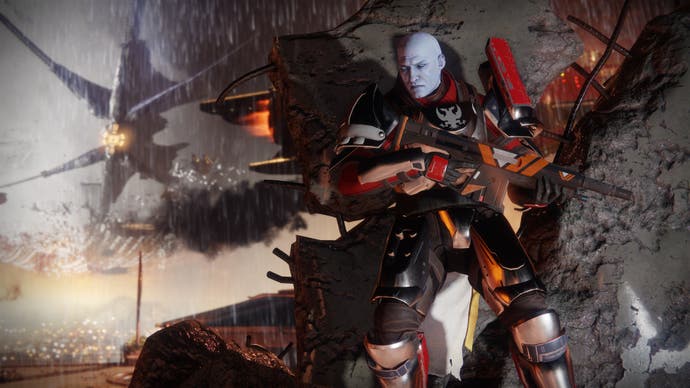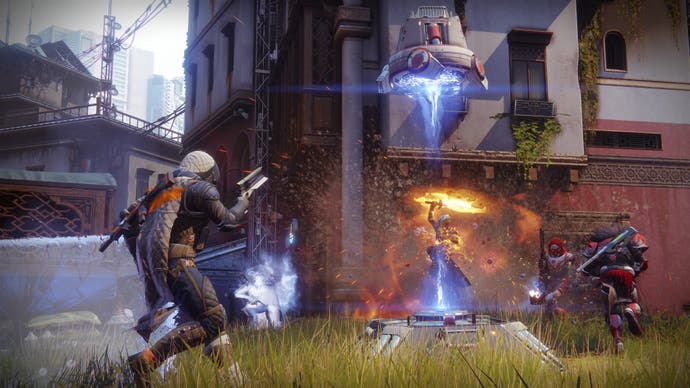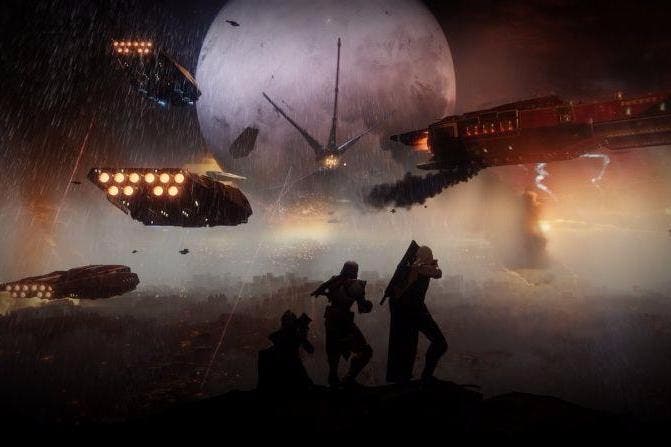Hands-on with Destiny 2 - a fun and familiar experience
Hard light.
After two hours playing Destiny 2 at its reveal event in Los Angeles yesterday, I can confidently say this: Bungie's sequel is a lot of fun to play, but it does feel very familiar.
It feels great, too, which will be no surprise to anyone who spent time with the first game. Bungie is, to my mind, the best in the world when it comes to making satisfying video game shooting, and there's a distinct 'if it ain't broke, don't fix it' vibe to Destiny 2. Bar a few small tweaks, the core gameplay loop of Destiny is preserved in its sequel.
Those tweaks are interesting, though. There are now two primary weapon slots - one for kinetic (non-elemental) damage weapons, and one for energy (elemental) damage weapons. So, you can have two hand cannons on the go, if you fancy it.
A by-product of this change is the third slot, now reserved for what are called power weapons as opposed to heavy weapons, is home to the likes of sniper rifles and shotguns. It was weird to play without having a shotgun or a sniper in the second weapon slot - one change among many I'll need time to get used to having pumped hundreds of hours into Destiny 1.
I played with two new weapon types: the SMG and the grenade launcher. The SMG goes in either the kinetic or energy weapon slot, and the grenade launcher is a power weapon. When I first used an SMG I found it similar to an auto rifle - it had a high rate of fire and packed a decent punch - but it felt more effective at closer ranges than an auto rifle.
The grenade launcher has a cool 'thunk' noise when the trigger is pulled (Bungie's always had superb weapon sound design in its games) and a modest splash damage effect on impact. I'm not sure the grenade launcher will replace the rocket launcher as my power weapon of choice when Destiny 2 comes out, but it was a lot of fun to try out new weapons nonetheless.

Each class of Guardian has a new subclass. I played as the Warlock Dawnblade, which replaces the ditched Sunsinger as a solar subclass. The super ability here lets you leap into the air and fire down solar sword strikes, then crash down with a sword slam. This felt like the most exciting of the three new supers the hands-on build had to offer, but ultimately it's similar to the Titan's hammer throw. It is something of a disappointment to find Destiny 2 does not add an entirely new class - we're still going to be playing as either a Hunter, Titan or Warlock.
One thing worth noting is that three of the stats present in Destiny 1 - strength, intellect and discipline - have been ditched. Now, you only have armour, agility and recovery to worry about when it comes to your Guardian's base stats. This is a sensible tweak to my mind, as the effect of the stats in Destiny 1 was vague at best.
Also worth noting is each class now has a third passive ability that sits alongside your grenade and melee attack on the main heads-up display. This ability is triggered by holding down the crouch button. My Warlock could either buff attack power or heal (I was able to select either for use in the Dawnblade path tech tree). What's good about these abilities is they make each class feel even more unique - and I'm all for the three Guardian classes playing as differently as possible.
The campaign
Bungie made a point of stressing the emphasis the game will have on the campaign, with more cutscenes and missions compared to Destiny 1. I got to play the game's opening mission, called Homecoming, which begins as the Cabal attack the Tower. I enjoyed this mission a lot - there's loads going on, with a lot of spectacular skybox action to gawp at, plenty of explosions, shooting and the odd quiet moment during which tension builds. It was particularly thrilling to fight through areas of the Tower I'd spent so many hours in messing about with my friends and fussing over loot and vault inventory space. There's even an Easter egg for Destiny fans - you walk past the fan favourite Sleeper bot, nonplussed as all hell breaks loose around him. He survives, I'm told, so expect him to pop up in a social space in Destiny 2.
The highlight of the mission was fighting alongside Zavala, one of the main characters from the Vanguard in the Tower in Destiny 1, now thrust into action in Destiny 2. Zavala, his back against cover, pops a Titan bubble, which you must hide inside during a Cabal missile barrage. As someone who spent a lot of time interacting with Zavala as a somewhat docile NPC in Destiny 1, it was a thrill to shoot aliens with him. But I can't imagine this set piece will have a similar impact on Destiny newcomers.

Despite the occasional cool scripted moment and stunning CGI cutscenes, Homecoming felt pretty familiar overall. It reminded me of the opening of The Taken King's story, which is no bad thing because The Taken King's story missions are among the best Destiny 1 has to offer. But while Homecoming was certainly cool to play, it could easily have been a Destiny 1 mission.
The strike
It was then on to a Strike - a three-player co-op mission called The Inverted Spire. This is set on Nessus, one of the four brand new worlds that make up Destiny 2. As a play space, Nessus felt like a splice between Cabal technology and the kind of Vex architecture we're used to from Destiny 1 world, Venus. Gameplay wise, the strike felt pretty familiar, with lots of shooting Vex and Cabal and leaping about platforms. It was a lot of fun to try out my new Warlock powers and the new guns as part of a Fireteam, but fundamentally I was doing much the same stuff I've done thousands of times in strikes in Destiny 1.
There were a few interesting moments, however. Throughout the strike you're on comms not only with your ghost, voiced by Nolan North, but also a female-voiced AI who sounds like she calls Nessus her home. There's some cute banter between the two as you shoot Cabal and Vex to bits.

The highlight of the strike for me was fighting through a huge Cabal drill site. As you make your way deeper underground, you have to dodge the whirling metal of the giant drill. The Cabal, it turns out, are on the hunt for the Modular Mind, a giant Vex boss reminiscent of some of the Vex bosses from Destiny 1. The fight itself is a three-stage affair. After you whittle down the Modular Mind's health to a certain point, the floor evaporates and you fall down to a lower level to continue the fight. The boss looked the part, but it felt a bit like a bullet sponge - a criticism I'd thought we'd left behind when The Taken King came out.
As for the Cabal, there were a few new enemy types to contend with, including a rabid dog thing that attacked in packs, and a melee focused Cabal that wields dual blades. To me, the Cabal behaved similarly to how they fought in Destiny 1, but a little more in your face. Some of the new Cabal units rush you, whereas before they were a tad standoffish. This change is definitely welcome, but I didn't detect an AI revolution. In truth, I wish I'd battled a brand new alien race, as opposed to a different version of an existing one.
The Crucible
One of the more interesting changes Bungie has made for Destiny 2 is moving from 6v6 in competitive multiplayer to 4v4 across all PvP modes. It's a curious decision - I don't think there's much wrong with 6v6 for Destiny's PvP. If anything, the number of players could have done with going up! But Crucible fans will now have to get used to 4v4 and what to me felt like a tighter, more teamwork-reliant experience.
I played a brand new game mode called Countdown on an Earth map called Midtown. Here, two teams of four fight over bombs you either have to arm and defend, or assault and disarm. Immediately muscle memory honed over hundreds of hours of Destiny 1 playtime kicked in, and I found myself employing similar tactics as I do on Salvage in Destiny 1.

Elsewhere, the PvP felt very familiar. Destiny 2's Crucible has some useful user interface improvements, such as displaying how close all the players are to super and how many revives remain, but on the whole it felt like the same PvP I know and love from Destiny 1. In fact, Countdown could easily be a new Destiny 1 Crucible mode.
The verdict
The sense of familiarity I felt as I played Destiny 2 is not necessarily a bad thing. There's a lot that Destiny 1 got right, so I'm glad a lot is staying the same for the sequel. But there's a part of me that had hoped for more from my hands-on time with Destiny 2, even though as I write this I'm reminding myself that I'll end up pumping hundreds of hours into it with my clan mates.
What excites me about Destiny 2 was talked about, rather than made available for hands-on. Bungie talked a lot about making the campaign more meaningful this time around, and I'm keen to see how that pans out. The sense I get is the three main Vanguard characters - Zavala, Ikora and Cayde - all bugger off to one of the four new worlds, and you have to travel to each to get them back on track, all the while regaining your light, and your powers after the Cabal strangle the life out of the Traveller. I'm particularly hopeful for Destiny lore revelations. What's the Traveller's true motivation? What's the Speaker doing? Why do Guardians resurrect every time they die? What, exactly, is the Darkness? It's time for an explanation.
I also love the sound of the new patrol mode. Bungie talked about the Destiny 2's worlds being massive but they're also said to be full of secrets and side missions. Destiny 1's play spaces were big but lifeless. There was little point exploring because there were no rabbit holes to tumble down. With Luke Smith, chief developer of the mysterious Vault of Glass and the secret-filled Dreadnought, I have high hopes for the European Dead Zone, Titan, Nessus and Io. And of course the raid. The raid!
If my hands-on time with Destiny 2 proved one thing, it's that Bungie is sticking to its guns for the sequel. The game is billed as a fresh start for the franchise, but it by no means tears up the Destiny rulebook. Story wise, the game continues on from Destiny 1 and leans heavily on an assumed familiarity with characters only the most diehard of Destiny fans will give two hoots about. Gameplay wise, the core loop remains the same, but with a handful of quality of life improvements that should spark the interest of many a lapsed Destiny fan. Destiny 2 is an experience streamlined, a collection of worlds less frustrating to navigate, and a suite of activities more respectful of your time. Destiny 2 feels like more of what I loved about Destiny 1, with improvements the community has clamoured for ever since Destiny came out back in 2014. As a huge Destiny fan, it's hard not to get excited by this.
But where's the spark? Where's the justification for that big 2 that adorned the Destiny 2 gameplay reveal? I've yet to unearth it, but I'm confident it's there, in the raid itself, perhaps off the beaten track on Io or deep within a cave on Titan.
This article is based on a press trip to Los Angeles. Activision covered travel and accommodation costs.









